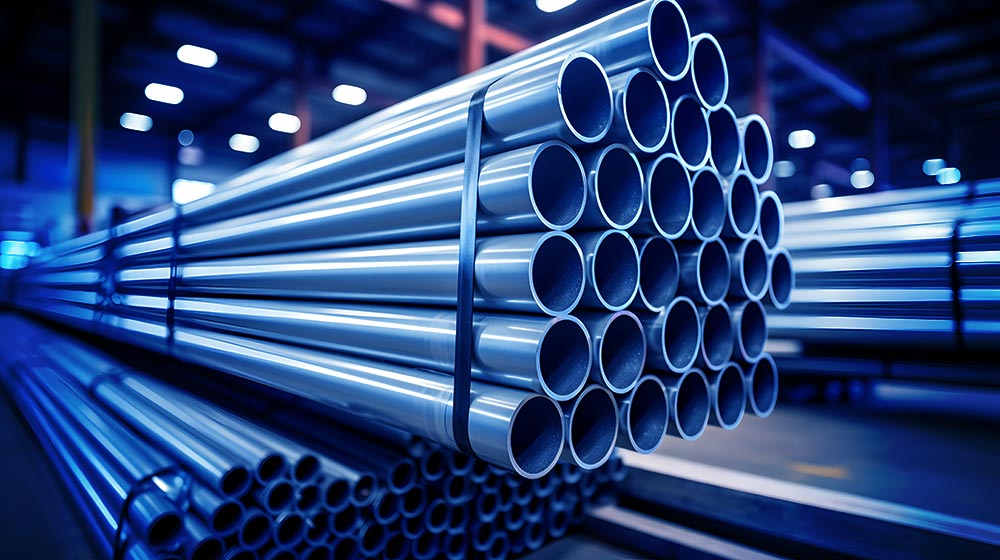MAXIMIZING ROI: HOW TO DETERMINE WHEN TO UPGRADE TO ALUMINUM COMPRESSED AIR PIPING
When should you consider replacing your aging iron distribution piping? Should you stick with the status quo or consider switching to aluminum pipes? While black iron piping is a common choice for compressed air distribution, this type of piping doesn’t last forever. Working with an aging distribution system could be costing you more than you realize. So what’s the return on investment (ROI) for transitioning to aluminum piping from iron?

What is the Lifespan of Compressed Air Piping?
The lifespan of your compressed air distribution system depends significantly on two key factors: The material selected for the piping system and the level of maintenance it receives. A black iron piping system can last 20 years or more given proper care, yet it may fail in as little as a decade. The large disparity in lifespan comes down to the moisture levels that are within the compressed air.
Iron piping is prone to corrosion when it encounters moisture, and as you know compressed air can often be full of moisture. When iron rusts, it results in the accumulation of corrosion, known as scale, within the pipes. As time progresses, this scale buildup gradually reduces the inner diameter of the pipe, restricting airflow. Rust flakes may dislodge inside the pipes, potentially obstructing inline filters or contaminating the air supply.
To extend the lifespan of your black iron piping, it’s essential to maintain dry air using air dryers and filters. Despite diligent care, completely removing all moisture and eventual corrosion is nearly impossible. Eventually, the piping will degrade and deteriorate to the point where replacement will be necessary.
Lifespan of Black Iron vs. Aluminum Piping
When comparing them, aluminum piping generally boasts a longer lifespan than black iron. With the appropriate maintenance, aluminum piping can endure for numerous decades. The key factor lies in their corrosion resistance: unlike iron, aluminum doesn’t rust. Instead, it forms a protective layer of aluminum oxide when exposed to oxygen, warding off further corrosion. This means aluminum distribution piping is less prone to the scale issues often encountered with black iron. Under similar operational and environmental conditions, aluminum piping is expected to outlive black iron by years, if not decades.
When to Replace Your Compressed Air Distribution Piping
Determining when to replace your black iron distribution piping involves observing various signs of degradation. These indicators may include leaks, increased pressure drop, clogged filters, and air contamination.
Leaks
Black iron piping is highly prone to developing leaks at its joints, often before corrosion becomes visibly prominent. As corrosion progresses, you may observe pinhole leaks initially, which can escalate to larger leaks within the pipe over time. These leaks can create significant challenges for both energy expenses and overall financial performance; on average, compressed air leaks cost manufacturers substantial sums annually. An aging iron distribution system may harbor numerous leaks, some too small to detect without specialized equipment. While these leaks can be temporarily patched or repaired, there comes a point where replacing the entire system proves more cost-effective than continually addressing newly forming leaks. Additionally, having a leaky distribution system places additional strain on your compressor as it struggles to meet air demands. This can lead to increased wear and tear causing a shortened service life on your compressor, resulting in heightened energy expenses for the overall system.
Excess Pressure Drop
As iron rusts, the inner corrosion of iron piping gradually reduces the pipe’s interior diameter, impacting airflow and causing the interior surface to become rough rather than smooth leading to disruption of the laminar flow of compressed air. You’ll also observe an increase in pressure drop throughout your distribution system. This heightened pressure drop forces your compressor to exert more effort in pushing air through the deteriorated distribution network, resulting in high energy costs and accelerated compressor wear. In severe cases of scale buildup, complete blockages can occur within the compressed air piping, particularly at joins and bends in the system as rust and other contaminants collected within the already narrowed pipe. Blockages like this can halt production or even lead to hazardous pipe failures.
Blocked Filters
We’re all accustomed to seeing the reddish flakes that form when iron rusts. As these tiny scale flakes detach inside the distribution piping, they get carried along with the airstream. Any rust particles dislodged before reaching an inline filter will be trapped by the filter media, safeguarding downstream processes from contamination. However in the presence of significant scale accumulation, filters will rapidly become clogged requiring more frequent replacements.
Contamination in Compressed Air
Iron particles within your piping system can also end up in the final air supply. Rust particles dislodged after the final inline filter will be present in the air you are using for your processes. The significance of this depends on your air quality standards, ranging from a minor inconvenience to a critical issue. Rust particles have the potential to harm pneumatic tools and equipment as well as cause product quality complications, such as issues with paint and coating spray application. If you must maintain a particular air purity standard, as outlined in ISO 8573-1:2010, any scale present in your air distribution system may lead to non-compliance.
The Financial Impact of a Declining Compressed Air Distribution System
An aging compressed air distribution system can contribute to increased operating costs through various channels, including:
- Wasted compressed air due to leaks in your system when compressed air is one of your most expensive utilities.
- Higher energy costs as a consequence of harder workload for your air compressor.
- Accelerated wear and tear on your compressor, resulting in a shortened service life.
- Elevated maintenance costs, including consumables such as filters and increased maintenance time.
- Compromised product quality resulting in inventory loss.
- Increased downtime required to address leaks and blockages within the system.
The ROI From Upgrading to Aluminum Compressed Air Piping
When it’s time for a distribution system upgrade, prioritizing a higher-quality and more durable piping system is financially beneficial. Although aluminum piping has a slightly higher initial cost compared to black iron, its long-term savings are significant and will pay for itself over time. Typically, it takes approximately five to seven years to recover the cost disparity between aluminum and iron through reduced operating expenses. Considering its extended service life, which often surpasses that of other materials by a considerable margin, the ROI for aluminum distribution piping is quite high and favorable.
Aluminum pays for itself by:
No Leaks
A top-notch aluminum piping system ensures leak-free performance both at installation and maintains the same performance level over time. Aluminum pipe fittings effectively prevent air leaks at joints, and because it doesn’t rust you can count on uninterrupted, leak-free service for an extended period of time. This preservation of compressed air minimizes wastage due to leaks, allowing for more efficient utilization in production applications.
Lower Pressure Drops
Since aluminum does not accumulate scale or rust within the lines, you’ll avoid the gradual pressure drop typically associated with black iron piping. This ensures consistently clear and unobstructed air lines for your systems.
Reduced Maintenance Issues
By eliminating scale and rust, you’ll encounter fewer challenges with your compressed air distribution system. This translates to less frequent changes of inline filters and a significantly reduced risk of pipe blockages. Additionally, your compressor motor will experience less wear and tear leading to a longer service life.
Cleaner Air
For those prioritizing air purity, aluminum emerges as the optimal choice. Similar to the high cost associated with stainless steel, its corrosion-resistant nature ensures cleaner air output. Aluminum is appropriate for nearly all purity levels except the most stringent, such as medical-grade or breathing air standards. Even in food and medical-grade scenarios, aluminum is frequently used up to the last filters, offering cost advantages over the pricier stainless steel options, along with reduced installation time.
Installation Costs: Aluminum vs. Black Iron
When installing a new compressed air distribution system or upgrading an existing one, it’s crucial to consider not just material expenses but also installation costs. Opting for a modular aluminum piping system significantly reduces installation time and eliminates the need for specialized tools, resulting in savings on both labor and downtime. These savings often account for a substantial portion of the cost disparity between aluminum and iron options.
Determining the Right Time to Upgrade to Aluminum Piping
Upgrading your compressed air distribution system is a significant investment in both time and money. While it’s important to maximize the service life of your existing aging black iron piping system, persistent issues like rapidly developing leaks, air contamination, substantial pressure drops, or an over-used compressor signal a potential need for an upgrade. When that time comes, transitioning to aluminum piping can be the smartest choice.
Interested in expanding the ROI of your compressed air distribution system? We’re here to help! Contact us today
The Basics of the Line Vac
Learn MoreElectronic Flow Controller
EFC is a user-friendly electronic flow control for compressed air that is designed to minimize compressed air use on blow off, drying, cooling, conveying and static elimination operations.
Learn More

